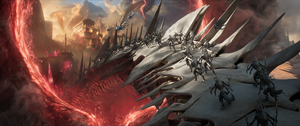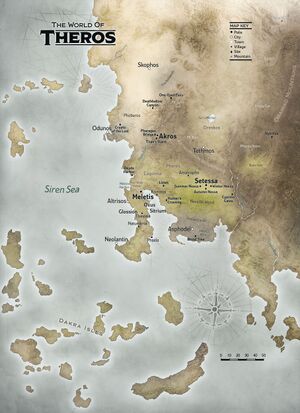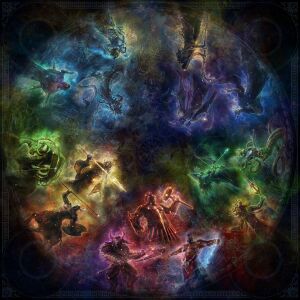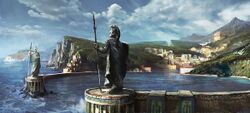Theros (plane)
| Theros | |
|---|---|
| Information | |
| Last seen | March of the Machine |
| Planeswalkers |
Calix (former) Gideon Jura Niko Aris (former) Xenagos |
| Rabiah Scale | 3½[1] |
| Status | Recovering from the New Phyrexian Invasion, pantheon decimated |
| Demonym | Theran[2] |
| Scryfall Statistics | |
|
1086 artworks | |
|
409 originated from | |
|
25 references | |
Theros is a plane where the Theros block and other Theros sets take place. It is similar to Hellenic Greece. The name may be from the Ancient Greek word θέρος (théros), meaning summer. The name may also be a portmanteau of the words "the" and "heroes", considering the heavy emphasis on Heroes on the plane.
Description
Theros is a plane governed by the gods of Nyx, where heroes face monsters, the sea rages, people offer burnt offerings and adventures take place. It is defined by mankind's struggle against the primal forces of the world, and mankind's conflict with the many other sapient races that populate the world.
Theros has a unique metaphysical property: things believed and dreamed here eventually become true.[3] The collective unconscious of millions of people has the literal power of creation, though the process unfolds over countless centuries. Thus the gods of Theros and their servants were believed, dreamed of, and narrated into existence, materializing, and becoming fully real as a result of mortal belief in their power.
Two closely related concepts loom large in the way mortals think about their place in the world: fate and destiny.[3] Fate is that which you cannot change, it is spun out in a tapestry woven by a trio of semi-divine women, The Fates. Destiny is that which you’re meant to do. While fate is what happens when you don’t take responsibility for your life, destiny is what happens when you commit to growing, learning, and taking chances. Being “destined for greatness” only comes through active and conscious decisions. But fate is what happens when you let other people and external circumstances dictate your life. The strands of destiny are spun from the hair of the ancient god Klothys.
More than just for their deeds, heroes fill an important role among the inhabitants of Theros.[3] Legendary heroes form a vast collection of archetypes (the Hunter, the General, the Philosopher, etc.) who embody the qualities to strive for and the potential of mortals to be more than mere drops in the raging river of fate.
History
The sealing of the titans
Thousands of years ago, before the current gods of Theros rose to power, the titans — horrific primal urges made flesh — roamed the mortal realm, sowing death and destruction in their wake.[4] The mortals, powerless to defend themselves, turned to prayer in their hour of need. From this prayer, this concentrated devotion sprang forth the gods themselves.
The oldest of the current gods, often considered siblings and some sort of offshoot from the Titans, are Klothys and Kruphix.[3] Perhaps the former arose from a sense of inevitability, and the latter of a sense of mystery. From them, the third generation of deities was born: sun-crowned Heliod, deep-dwelling Thassa, bleak-hearted Erebos, bronze-blooded Purphoros and keen-eyed Nylea. The other eight gods, the fourth generation, are sometimes thought to be their offspring.
Imbued with incredible power by the faith of mortals, the gods sealed the titans away in the Underworld. Klothys, the god of fate, volunteered to act as a jailer and sequestered herself in the Underworld for eternity. While Erebos rules this realm beyond death, it was Klothys who acted as an eternal seal, ensuring the Titans remained trapped.
The age of Trax
In ancient times, the archons of Trax held a massive empire, tyrannizing the world in the belief that they were imposing strict justice.[5][3] The most notable of these Archon tyrants was Agnomakhos, who used the leonin as an army. Giants, demons, and medusas are said to have reigned kingdoms of their own in those days. Dragons, Kraken, and Hydras used to be even larger than they are in the present time.
Eventually, the Archon empire fell, being instead replaced by the poleis, and the remaining Archons now lash at these, slighting the "honor" they feel was stripped from them.
Birth of the poleis
The end of the age of Trax corresponds roughly with the rise of the fourth and latest generation of the gods.[3] Ephara inspired and equipped the human heroes Kynaios and Tiro to overthrow Agnomakhos. They founded the polis Meletis, established its legal code, and defended it for decades. After the fall of the archons, humans and minotaurs waged a bloody war in the highlands. The poleis of Akros and Skophos were born from that bloodshed, inspired by the martial doctrines of Iroas and Mogis.
The age of heroes
The uncounted centuries since the fall of the archons have been marked by the exploits of great heroes, many of which have been recorded in epic works of epic prose and poetry. The tale of The Akroan War, is only nominally a history of the long siege of Akros, precipitated by the queen of Olantin abandoning her husband and going to live with the Akroan king. The Theriad tells the epic story of various unidentified adventurers who would each rise to become The Champion of the Sun God. The Callapheia recounts the adventures of Callaphe the Mariner.
The rise and fall of Xenagos
When the satyr planeswalker Xenagos returned to his birthplane, he found his old hedonistic lifestyle exceedingly dull and the gods to be a farce in which he was no longer willing to participate.[6] His ambitions had evolved into a desire for outright godhood, to join or replace the pantheon of Theros, and so he began gathering his forces of eldritch, otherworldly monsters to attack the poleis of Meletis, Akros, and Setessa. These attacks became so severe that the gods themselves began to go blind, cut off from their oracles. This drove them into a panic which escalated as they blamed the others of their kind for the transgression. Only Nylea seemed to be aware of the threat he played, but with his otherworldly magic, none of the gods could truly stop him. Seeing no other choice, Kruphix then enacted the Silence of the Gods, forcing the Theros's deities to remain in the Nyx without the possibility of interfering with mortal lives, including communicating with their oracles. This left Xenagos with the opportunity to rise to godhood without any further interference from his would-be rivals.[7]
Using the forced worhsip of mortal revelers, Xenagos managed to ascend to godhood. This occurred after a minotaur siege at Akros, battled off by armies led by Elspeth. The victory celebration turned into a Great Revel, and was the final ingredient to Xenagos' divine ascension. In the ensuing turmoil, the Sun god's champion was ironically scapegoated for this, resulting in her exile to the wilderness. Xenagos now held the position of the God of the revels, furthering the chaos and distrust of the established pantheon.[8] Heliod was particularly offended by his ascension and sought to destroy the satyr, whom he referred to as "the usurper". He planned to punish all of mortal-kind for the actions of the new god.
Xenagos had accomplished what he had desired: obtaining a place in the pantheon. However, he could not sustain his godly form by himself; he gathered a large array of Nyxborn creatures, using them to keep his position. Capturing the Nyxborn caused Theros's sky to darken, as chaos spread across the plane. His time in Nyx would not be long though. Only a couple of days after his rise, the planeswalkers Elspeth Tirel and Ajani Goldmane arrived in Nyx to set Theros right again. After a difficult battle, Xenagos managed to knock Elspeth down, planning on taking her weapon, Godsend, to keep his position firm. However, Elspeth managed to throw the spear into Xenagos's chest, causing the arrowhead, which Nylea had shot into Xenagos before his ascension, to explode and shred his beating heart. With the deicide in Nyx, Xenagos could not even manifest in the Underworld and is truly gone.[9]
As Xenagos's remnants fell back to Theros, Elspeth offered her life in trade for her lover Daxos. Erebos accepted her sacrifice and declared to Heliod that Elspeth must be delivered to him. After reclaiming Godsend, Heliod fatally wounded his former champion and instructed Ajani to carry Elspeth back to the mortal realm and deliver her to Erebos.[10]
War of the gods
Heliod contemplated the fragility of his immortality. He would not allow anyone to take his place in the pantheon — not even the other existing gods. To that end, he pulled the soul of the oracle Daxos and transformed him into his champion in the mortal realm.[11] Now a demigod, Daxos was instructed to remove all trace of the other gods from the great city of Meletis. The other gods, refusing to stand for such an affront, called upon their champions from the Underworld; with this, the gods were at war. Their strife led to unintended consequences, one of which began the opening of rifts between the Underworld and the mortal realm. This allowed Erebos's monsters and the titans to pour forth and sow chaos. Also in the Underworld, Elspeth became empowered by Ashiok, who equipped her with a weapon created from her past traumas. She also managed to escape the Underworld and planned to assassinate Heliod. The god Klothys sent the nyxborn Calix to bring her back.
Elspeth claimed that the Shadowspear was the true Khrusor and that Heliod's spear was a fake. Due to the nature of belief on Theros, when mortals started to acknowledge Shadowspear as the true Khrusor, Heliod's spear weakened to the point of shattering when clashing against Elspeth's weapon. The God of the Sun was forced to yield and Erebos imprisoned him in the Underworld forever. By defeating his most hated enemy, Elspeth won the God of the Dead's eternal gratitude and permission to return to the world of the living. After meeting with Daxos one last time, Elspeth planeswalked away, with Calix, whose spark ignited in the meantime, following her.
Phyrexian invasion

Led by a Phyrexian Ajani Goldmane, the first wave of the invasion targeted temples and other places of worship.[12] Due to the nature of faith on Theros, compleating the gods' devotees meant that the gods themselves, influenced by their new Phyrexian worshippers, succumbed and became Phyrexians as well.
In the course of the invasion, most of the gods were compleated.[13] The city of Meletis stood as the last bastion of resistance against an endless onslaught of Phyrexian armies.[12] Hordes of Phyrexian monstrosities assailed the city from air, land, and sea, while Meletian defenders fought valiantly to drive them off. With the aid of Ephara, one of the few surviving Theros gods, sustained by the belief of those within the city walls, they managed to hold their own. Outside of Meletis, the omenpaths of Realmbreaker reached into the underworld, where they were met with Kroxa, whose voiding maw completely obliterated the invaders.
Once the tide had turned and New Capenna's angels led a counter-invasion of Theros, the compleated Heliod was distracted enough to be killed by Kaya Cassir.[14] Though Ephara's survival, Heliod's death, and Erebos's compleation is confirmed, it is unclear which of the other Gods were compleated in the invasion. It is implied that Athreos may have survived, having given orders to Kunaros, and that all five of the mono-colored gods may have been compleated.[15][16] Cymede, last seen ascending to Keranos's side in Nyx, was compleated, suggesting Keranos was also.[17]
In the aftermath, word of Elspeth's ascension and victory reached Theros, with statues built in her honor in restored temples, suggesting a new god will be borne from this worship.[18]
Sets
The following sets have taken place on Theros:
Locations

Theros is divided into three main realms - the Mortal Realm, Nyx, and the Underworld. See each individual realm for specific locations.
- The Mortal Realm, or material plane, is Theros’s sunlit world of the living — about 40,000 square miles of known land within a far larger, mostly unexplored continent.[19] It’s bounded by the Siren Sea to the west and the vast Nistos Forest to the east,[10] and is the only Therosian realm that can be directly planeswalked into or out of.[20] As a plane where mankind is carving out a place for civilization in the wild, Theros has several main city-states, or "poleis" (singular polis),[21] born from relevant areas of the now-defunct Archon empire, with fewer, smaller settlements here and there.
- Nyx - a mystical realm tied to dreams, the subconscious, and the night sky where the gods dwell. Deities manifest with star-filled shadows, reflecting Nyx’s celestial nature. Dreams and enchantments are seen as divine gifts from Nyx, which mortals "visit" in sleep. Tales of the gods appear among the constellations.[22]
- The Underworld - a subterranean realm where the dead reside. Ruled by Erebos, who was cast therre by a fearful Heliod after his birth. Though dark, it is not connected to Nyx, lacking both sun and night. Souls dwell in regions matching their lives.
Religion

Gods
First Generation (Titans)
- Kroxa, Titan of Death's Hunger
- Phlage, Titan of Burning Wind
- Skotha, Titan of Eternal Dark
- Uro, Titan of Nature's Wrath
Second Generation
Third Generation
- Heliod, God of the Sun (
) (deceased)
- Thassa, God of the Sea (
)
- Erebos, God of the Dead (
)
- Purphoros, God of the Forge (
)
- Nylea, God of the Hunt (
).
Fourth Generation
- Athreos, God of Passage (
)
- Ephara, God of the Polis (
)
- Iroas, God of Victory (
)
- Karametra, God of Harvests (
)
- Keranos, God of Storms (
)
- Mogis, God of Slaughter (
)
- Pharika, God of Affliction (
)
- Phenax, God of Deception (
)
Cult Gods
- Cacophony, God of Cities. A newborn god which was quickly slain by Ephara.[23]
- Xenagos, God of Revels (
), the satyr planeswalker who ascended to godhood before being slain by Elspeth Tirel.
- An unknown God of Love, now forgotten.[24]
- Marit Lage[25] (non-canon)
Inhabitants
Sapient races
Artificial
Other
- Badgers
- Basilisks
- Birds
- Boars
- Catoblepas
- Cats
- Cerberi
- Chimeras
- Cockatrices
- Crabs
- Dragons
- Elementals
- Elks
- Foxes
- Griffins
- Hippocamps
- Horrors
- Hydras
- Insects
- Leeches
- Lizards
- Krakens
- Manticores
- Nautilus
- Nightmares
- Octopuses
- Pegasi
- Phoenixes
- Scorpions
- Serpents
- Sheep
- Skeletons
- Snakes
- Spiders
- Starfish
- Treefolk
- Turtles
- Unicorns
Languages spoken
- Theran [26]
- The citizens of the three human poleis speak their dialects of the Common language.
- Leonin and minotaurs have their languages, and tritons speak the Aquan dialect of Primordial.
- Centaurs and satyrs speak distinct dialects of Sylvan.
- Giants and cyclopses share one language.
- Dragons and sphinxes have distinct languages rarely spoken among mortals.
- The gods themselves speak the unique language of Nyx, that few beyond mortal oracles can understand.[27]
Planeswalkers
Native
Visitors
In-game references
- Represented in:
- Associated cards:
- Referred to:
- Alabaster Host Sanctifier
- Amateur Auteur (Unstable, #3c)
- Dawnbringer Charioteers
- Eidolon of the Great Revel
- Extinguish All Hope (Commander Masters, #157)
- Furious Rise
- Gods Willing (Theros)
- Hall of Heliod's Generosity
- Harried Artisan
- Heliod, the Warped Eclipse
- Mana Confluence (Journey into Nyx)
- Mindwrack Harpy
- Mischief and Mayhem
- Nessian Boar
- Plea for Guidance
- Reckless Reveler
- Spear of Heliod
- Tranquil Cove (March of the Machine)
- Unravel the Aether
- Urn of Godfire
References
- ↑ Mark Rosewater (October 03, 2024). "Invoking my birthday trivia right to request some fun fact about theros, and/or where is theros on the rabiah scale.". Blogatog. Tumblr.
- ↑ Alison Lührs (March 24, 2023). "March of the Machine - Ravnica: One and the Same". magicthegathering.com. Wizards of the Coast.
- ↑ a b c d e f Wizards RPG Team (2020), D&D Mythic Odysseys of Theros, Wizards of the Coast
- ↑ Wizards of the Coast (January 10, 2020). "Theros Beyond Death Story Summary". magicthegathering.com. Wizards of the Coast.
- ↑ Magic Creative Team (September 4, 2013). "Planeswalker's Guide to Theros Part 3". magicthegathering.com. Wizards of the Coast. Archived from the original on 2021-04-29.
- ↑ Xenagos. Planeswalker Biography. Wizards of the Coast. Retrieved on October 02, 2013.
- ↑ Jenna Helland (2014) - Theros: Godsend, Part I, WotC.
- ↑ The Magic Creative Team (January 08, 2014). "Planeswalker's Guide to Born of the Gods". magicthegathering.com. Wizards of the Coast.
- ↑ Mark Rosewater (March 11, 2019). "Where It's At". magicthegathering.com. Wizards of the Coast.
- ↑ a b Jenna Helland (2014), "Journey into Nyx: Godsend, Part II. Wizards of the Coast"
- ↑ Wizards of the Coast (January 10, 2020). "Theros Beyond Death Story Summary". magicthegathering.com. Wizards of the Coast.
- ↑ a b Emily Teng (April 11, 2023). "Planeswalker's Guide to March of the Machine: The Phyrexian Invasion of the Multiverse". magicthegathering.com. Wizards of the Coast.
- ↑ Mark Rosewater (April 10, 2023). "Choosing Your Battles, Part 1". magicthegathering.com. Wizards of the Coast.
- ↑ a b K. Arsenault Rivera (March 28, 2023). "March of the Machine - Episode 9: The Old Sins of New Phyrexia". magicthegathering.com. Wizards of the Coast.
- ↑ Emily Teng (April 13, 2023). "The Legendary Team-Ups of March of the Machine". magicthegathering.com. Wizards of the Coast.
- ↑ Flavor text of Ephara, Ever-Sheltering
- ↑ Flavor text of Phyrexian Pegasus
- ↑ Flavor of Deification
- ↑ J.R. Zambrano (May 28, 2020). "D&D: Massive New Mythic Odysseys Of Theros Rules". Belloflostsouls.com.
- ↑ Doug Beyer (June 01, 2014). "So is Elspeth less dead on Theros than she would be on any other plane?". A Voice for Vorthos. Tumblr.
- ↑ Trick Jarrett (November 19, 2013). "Symbols of the Poleis". magicthegathering.com. Wizards of the Coast. Archived from the original on 2020-11-11.
- ↑ Wizards of the Coast. (4 Sep 2013.) "PAX Prime 2013 - Theros World Building Panel", Magic: The Gathering account on YouTube
- ↑ Ken Troop (April 23, 2014). "Dreams of the City". magicthegathering.com. Wizards of the Coast.
- ↑ Kelly Digges (June 11, 2014). "Kruphix's Insight". magicthegathering.com. Wizards of the Coast.
- ↑ a b c MacKay, Jed. (2021). Magic. Vol 1, Iss 8.
- ↑ Mira Grant (Aug 20, 2024). "Duskmourn: House of Horror - Episode 2: Don't Split the Party". magicthegathering.com. Wizards of the Coast.
- ↑ Jenna Helland (2014) - Theros: Godsend, Part I, WotC, Prologue.
- ↑ Gerrit Turner (December 14, 2020) "Creating Niko Aris"
- ↑ a b c d e f g h Greg Weisman (November 2019). "War of the Spark: Forsaken". Del Rey.
- ↑ Emrakul & Chatterfang!? Koma & Toski!? 62 Unknown Magic Cards! (Video). Good Morning Magic. YouTube (May 10, 2023).
Trivia
Theros in ancient Greek mythology is the name of one of the Horae. Theros is the goddess who personifies the summer.
External links
- The Magic Creative Team (August 21, 2013). "Planeswalker's Guide to Theros, Part 1". magicthegathering.com. Wizards of the Coast.
- The Magic Creative Team (August 28, 2013). "Planeswalker's Guide to Theros, Part 2". magicthegathering.com. Wizards of the Coast.
- The Magic Creative Team (September 04, 2013). "Planeswalker's Guide to Theros, Part 3". magicthegathering.com. Wizards of the Coast.
- The Magic Creative Team (January 08, 2014). "Planeswalker's Guide to Born of the Gods". magicthegathering.com. Wizards of the Coast.
- The Magic Creative Team (April 02, 2014). "Planeswalker's Guide to Journey into Nyx". magicthegathering.com. Wizards of the Coast.
- Wizards RPG Team (2020). D&D Mythic Odysseys of Theros. Wizards of the Coast.
